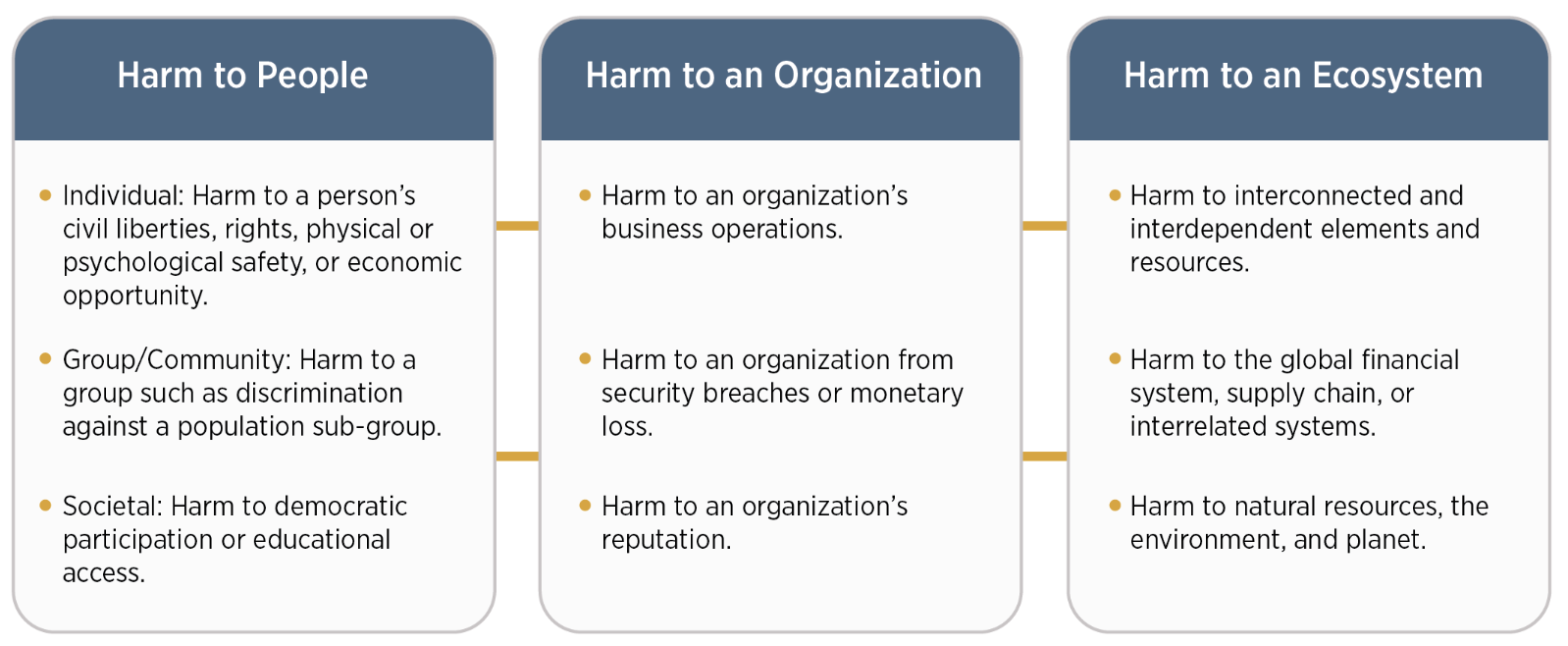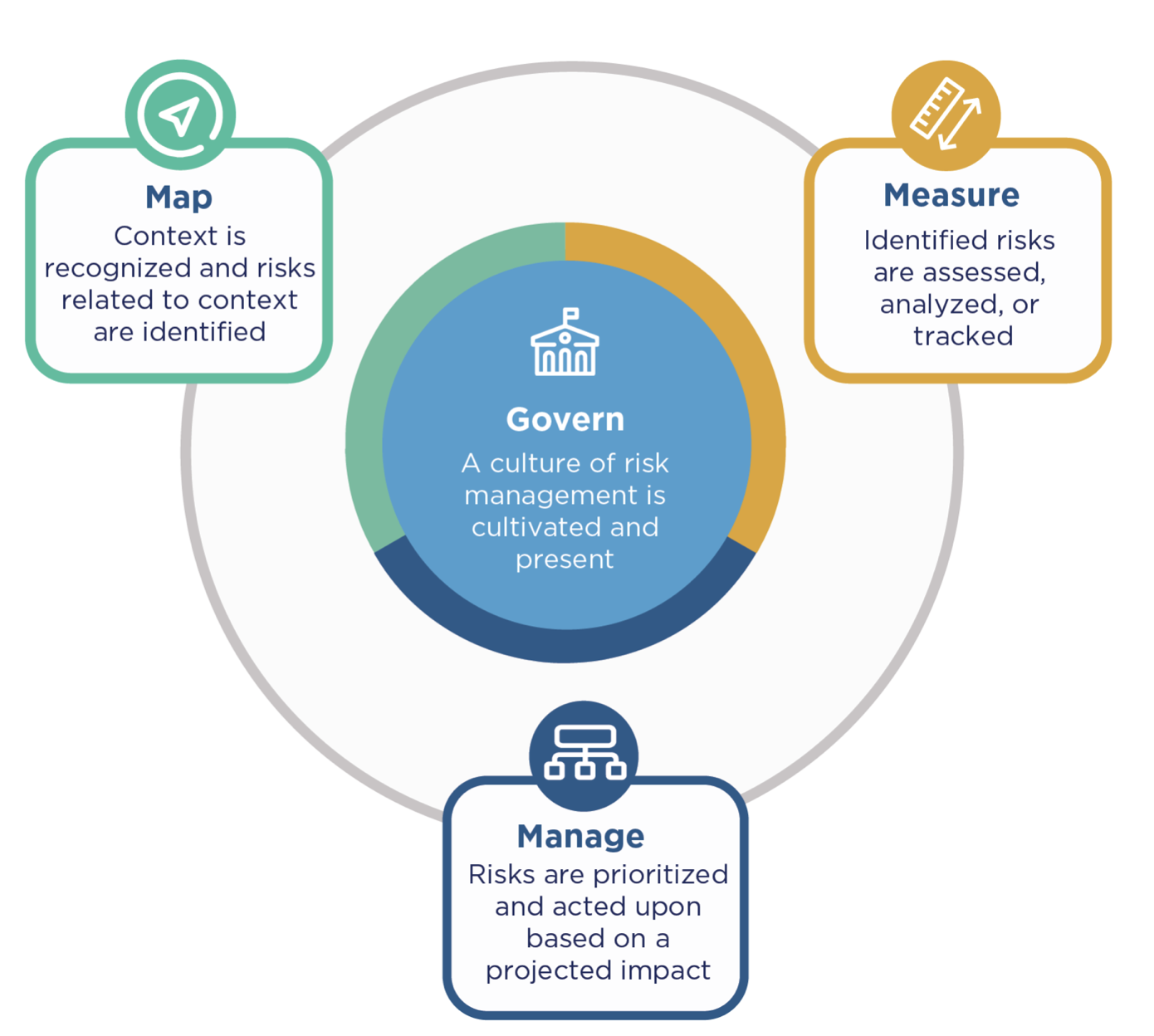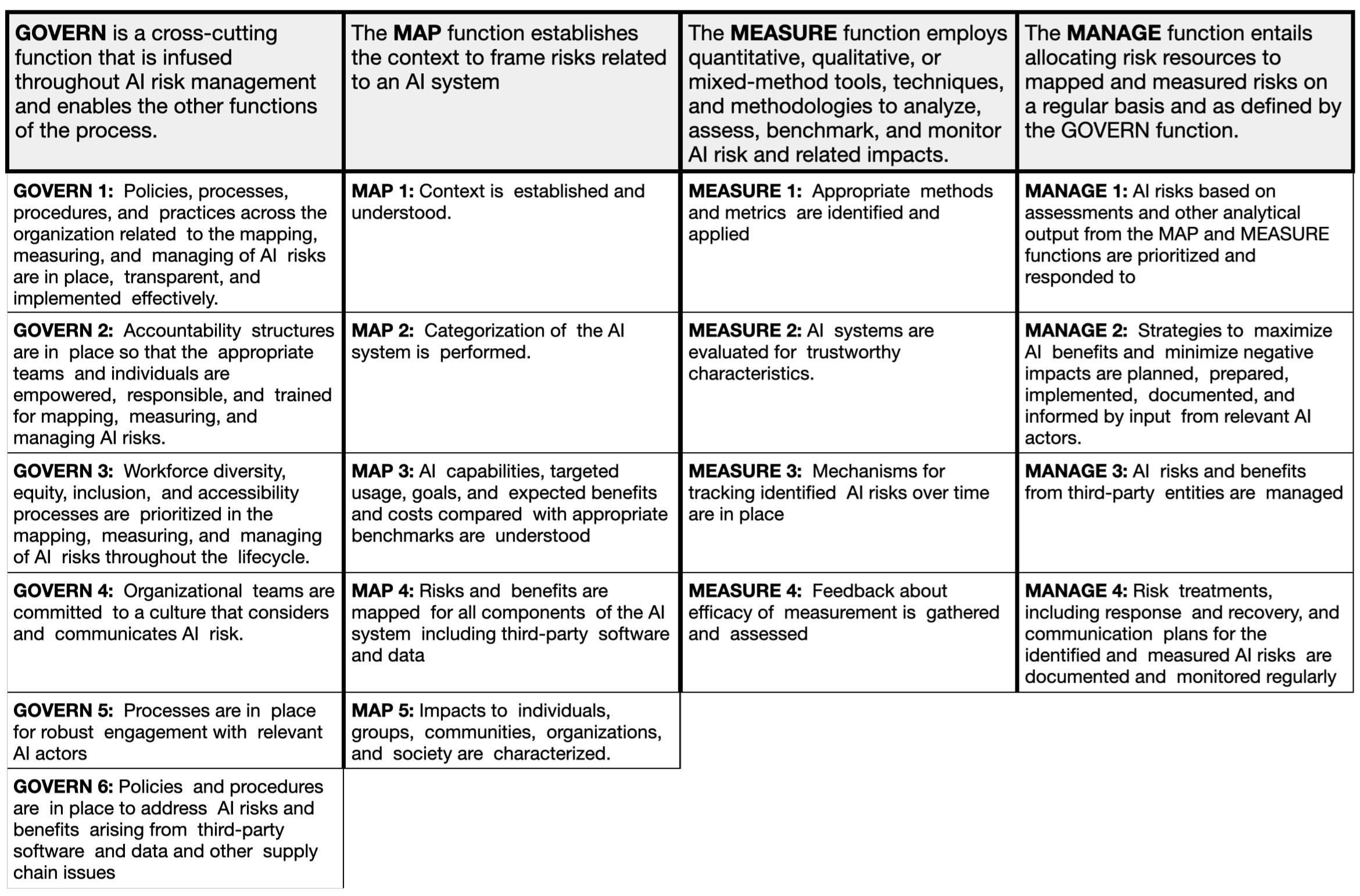Chapter 5 NIST AI Risk Management Framework (AI RMF)
The National Institute of Standards and Technology (NIST) was founded in 1901 and is now part of the U.S. Department of Commerce. NIST mission is to promote U.S. innovation and industrial competitiveness by advancing measurement science, standards, and technology in ways that enhance economic security and improve our quality of life.
In collaboration with the private and public sectors, NIST has developed a framework to better manage risks to individuals, organizations, and society associated with artificial intelligence (AI). The NIST AI Risk Management Framework (AI RMF) it is designed for voluntary adoption, aiming to enhance trustworthiness of AI solutions. First version of this framework was released on January 26, 2023. Two months later, on March 30, NIST launched the Trustworthy and Responsible AI Resource Center, which will facilitate implementation of, and international alignment with, the AI RMF.
A key starting point for the NIST RMF [6] is the observation that the risks associated with systems using ML and AI components are different from those for classical IT systems. Examples of these differences are numerous, such as the adaptive nature of ML modules that adjust to training data that may change over time, the black box nature of many ML/AI systems, the multiplicity of applications for ML/AI modules that may have been trained on non-representative data. For this reason, although there are many other tools for managing risks in AI systems, a new standard for managing risks in AI-based systems is needed.
5.1 Risks
In the context of the AI RMF, risk refers to the composite measure of an event’s probability of occurring and the magnitude or degree of the consequences of the corresponding event.
AI risk management offers a path to minimize potential negative impacts of AI systems, such as threats to civil liberties and rights, while also providing opportunities to maximize positive impacts. Addressing, documenting, and managing AI risks and potential negative impacts effectively can lead to more trustworthy AI systems.

5.2 Characteristics of trustworthy AI systems
A comprehensive approach to risk management calls for balancing tradeoffs among the trustworthiness characteristics.

5.2.1 Valid and Reliable
Validation is the “confirmation, through the provision of objective evidence, that the requirements for a specific intended use or application have been fulfilled” (ISO 9000:2015)
Reliability is defined in the same standard as the “ability of an item to perform as required, without failure, for a given time interval, under given conditions” (ISO/IEC TS 5723:2022).
Accuracy is the “closeness of results of observations, computations, or estimates to the true values or the values accepted as being true.” (ISO/IEC TS 5723:2022)
Robustness or generalizability is defined as the “ability of a system to maintain its level of performance under a variety of circumstances” (ISO/IEC TS 5723:2022)
5.2.2 Safe
Safe AI systems should “not under defined conditions, lead to a state in which human life, health, property, or the environment is endangered” (ISO/IEC TS 5723:2022).
Resilient system can withstand unexpected adverse events or unexpected changes in their environment or use – or if they can maintain their functions and structure in the face of internal and external change and degrade safely and gracefully when this is necessary (ISO/IEC TS 5723:2022).
Secure AI system can maintain confidentiality, integrity, and availability through protection mechanisms that prevent unauthorized access and us.
5.2.3 Accountable and Transparent
Transparency reflects the extent to which information about an AI system and its outputs is available to individuals interacting with such a system – regardless of whether they are even aware that they are doing so.
Accountability presupposes transparency.
5.2.4 Explainable and Interpretable
Explainability refers to a representation of the mechanisms underlying AI systems’ operation, whereas interpretability refers to the meaning of AI systems’ output in the context of their designed functional purposes.
Transparency, explainability, and interpretability are distinct characteristics that support each other. Transparency can answer the question of “what happened” in the system. Explainability can answer the question of “how” a decision was made in the system. Interpretability can answer the question of “why” a decision was made by the system and its meaning or context to the user.
5.2.5 Privacy-Enhanced
Privacy refers to the norms and practices that help to safeguard human autonomy, identity, and dignity. These norms and practices typically address freedom from intrusion, limiting observation, or individuals’ agency to consent to disclosure or control of facets of their identities (e.g., body, data, reputation).
5.2.6 Fair – with Harmful Bias Managed
Fairness in AI includes concerns for equality and equity by addressing issues such as harmful bias and discrimination. Standards of fairness can be complex and difficult to define because perceptions of fairness differ among cultures and may shift depending on application.
Bias is broader than demographic balance and data representativeness. NIST has identified three major categories of AI bias to be considered and managed: systemic, computational and statistical, and human-cognitive.
5.3 AI RMF Core
5.3.1 Functions
The actions that can be taken in risk management are grouped into categories and subcategories. These in turn are grouped into four overarching functions in risk management, these are Govern, Map, Measure and Manage.
Risk management is an ongoing process that requires taking into account different perspectives. These four functions correspond to the main perspectives that need to be considered throughout the life cycle of an AI system.

5.3.2 Cartegories
Cartegories, subcartegories, outcomes and actions are listed in [6] https://nvlpubs.nist.gov/nistpubs/ai/NIST.AI.100-1.pdf#page=29.65

5.4 Adversarial Machine Learning
A good companion to the RMF Framework is another NIST document ,,Adversarial Machine Learning. A Taxonomy and Terminology of Attacks and Mitigations’’ [7]. It presents an up-to-date map of available attacks on predictive models with a particular focus (unlike OWASP and MITTRE) on the model perspective. The standard includes detailed explanations of each type of attack with examples. A concise summary of the attacks discussed is provided in the figure below.
![Reconstruction of Figure 1 from the ,,Taxonomy of attacks on Predictive AI systems’’ [7]](images/NIST_attacks.png)
5.5 Other relevant NIST initiatives
NIST has also produced a number of other documents and standards of interest from a model analysis perspective.
- Reducing Risks Posed by Synthetic Content. An Overview of Technical Approaches to Digital Content Transparency. [8]. a broad discussion of systems for generative AI and, in particular, techniques for detecting the provenance of text, image, audio and video content.
![Figure 2 from draft of [8]](images/NIST_IR_8269.png)